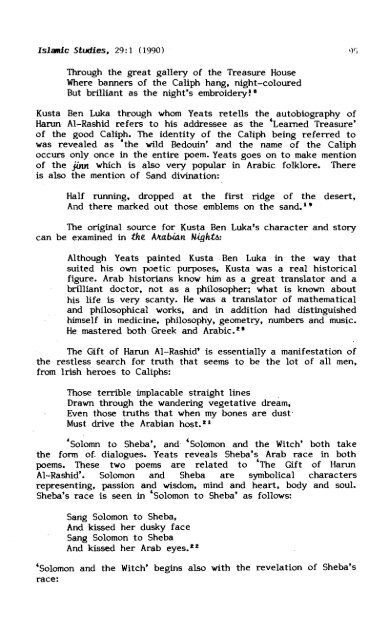You also want an ePaper? Increase the reach of your titles
YUMPU automatically turns print PDFs into web optimized ePapers that Google loves.
Isldc Studies, 29: 1 ( 1990)<br />
Through the great gallery of the Treasure House<br />
Where banners of the Caliph hang, night-coloured<br />
But brilliant as the night's emb~oidery!~<br />
Kusta Ben Luka through whom Yeats retells the' autobiography of<br />
Harun Al-Rashid refers to his addressee as the Learned Treasure'<br />
of the good Cali~h. The identity of the Caliph being referred to<br />
was revealed as the wild Bedouin' and the name of the Caliph<br />
occurs only once in the entire poem. Yeats goes on to make mention<br />
of the which is also very popular in Arabic folklore. There<br />
is also the mention of Sand divination:<br />
Half running, dropped at the first ridge of the desert,<br />
And there marked out those emblems on the sand.''<br />
The original source for Kusta Ben Luka's character and story<br />
can be examined in the Afiakn Nigh:<br />
Although Yeats painted Kusta Ben Luka in the way that<br />
suited his own poetic purposes, Kusta was a real historical<br />
figure. Arab historians know him as a great translator and a<br />
brilliant doctor. not as a philosopher; what is known about<br />
his life is very scanty. He was a translator of mathematical<br />
and philosophical works, and in addition had distinguished<br />
himself in medicine, philosophy, geometry, numbers and music.<br />
He mastered both Greek and Arabic.='<br />
The Gift of Harun Al-Rashid' is essentially a manifestation of<br />
the restless search for truth that seems to be the lot of all men,<br />
from lrish heroes to Caliphs:<br />
Those terrible implacable straight lines<br />
Drawn through the wandering vegetative dream,<br />
Even those truths that when my bones are dust<br />
Must drive the Arabian host.21<br />
'~olomn to Sheba', and '.Solomon and the Witch' both take<br />
the form of. dialogues. Yeats reveals Sheba's, Arab race in both<br />
poems. These two poems are related to The Gift of Harun<br />
Al-Rashid'. Solomon and Sheba are symbolical characters<br />
representing, passion and wisdom, mind and heart, body and soul.<br />
Sheba's race is seen in '~olomon to Sheba' as follows:<br />
Sang Solomon to Sheba,<br />
And kissed her dusky face<br />
Sang Solomon to Sheba<br />
And kissed her Arab eyes.* *<br />
'.Solomon and the Witch' begins also with the revelation of Sheba's<br />
race:
















